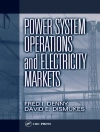Interest in power systems economics is gaining momentum with the
recent power supply shortages in America and the rising cost of
fossil fuels. The involvement of independent power generators,
brokers and distributors has changed the way in which power systems
operate. Kirschen and Strbac use a combination of traditional
engineering techniques and fundamental economics to address the
long-term problems of power system development in a competitive
environment. Power system engineers, operators, planners and policy
makers working in the deregulated environment will value this
practical guide, also of great interest to postgraduate and
advanced undergraduate students in electrical and power
engineering.
* Outlines the principles of competitive electricity markets
alongside the operation and development of the supporting
transmission and distribution networks
* Applies basic economic principles to power system operating and
planning
* Written by recognised experts in the field
For further information and to register for the solutions
manual visit:
http://www.wiley.com/go/powersystemeconomics
表中的内容
Preface.
1. Introduction.
1. Why Competition?
2. Dramatis Personae.
3. Models of Competition.
4. Open Questions.
5. Further Reading.
6. Problems.
2. Basic Concepts from Economics.
1. Introduction.
2. Fundamentals of Markets.
3. Concepts from the Theory of the Firm.
4. Types of Markets.
5. Markets with Imperfect Competition.
6. Further Reading.
7. Problems.
3. Markets for Electrical Energy.
1. Introduction.
2. What is the Difference between a Megawatt-hour and a Barrel
of Oil?
3. The Need for a Managed Spot Market.
4. Open Electrical Energy Markets.
5. The Managed Spot Market.
6. The Settlement Process.
7. Further Reading.
8. Problems.
4. Participating in Markets for Electrical Energy.
1. Introduction.
2. The Consumer’s Perspective.
3. The Producer’s Perspective.
4. Perspective of Plants with Very Low Marginal Costs.
5. The Hybrid Participant’s Perspective.
6. Further Reading.
7. Problems.
5. System Security and Ancillary Services.
1. Introduction.
2. Describing the needs.
3. Obtaining Ancillary Services.
4. Buying Ancillary Services.
5. Selling Ancillary Services.
6. Further Reading.
7. Problems.
6. Transmission Networks and Electricity Markets.
1. Introduction.
2. Decentralized Trading over a Transmission Network.
3. Centralized Trading over a Transmission Network.
4. Further Reading.
5. Problems.
7. Investing in Generation.
1. Introduction.
2. Generation Capacity from an Investor’s Perspective.
3. Generation Capacity from a Customer’s Perspective.
4. Further Reading.
5. Problems.
8. Investing in Transmission.
1. Introduction.
2. The Nature of the Transmission Business.
3. Cost-based Transmission Expansion.
4. Value-based Transmission Expansion.
5. Further Reading.
6. Problems.
Appendix: Answers to Selected Problems.
Abbreviations and Acronyms.
Index.
关于作者
Daniel Kirschen; Daniel Kirschen joined the University of Washington in 2011 after spending 16 years at the University of Manchester – previously UMIST – where he was head of the Electrical Energy and Power Systems research group.












